Fracture of the scapula
Fracture of the scapula (shoulder blade) is generally the direct result of the impact of a fall or an automobile collision. Dislocations of the shoulder joint, sprains and contusions are common in this area. First aid consists of applying a sling and bandaging the victim’s upper arm to his chest wall.
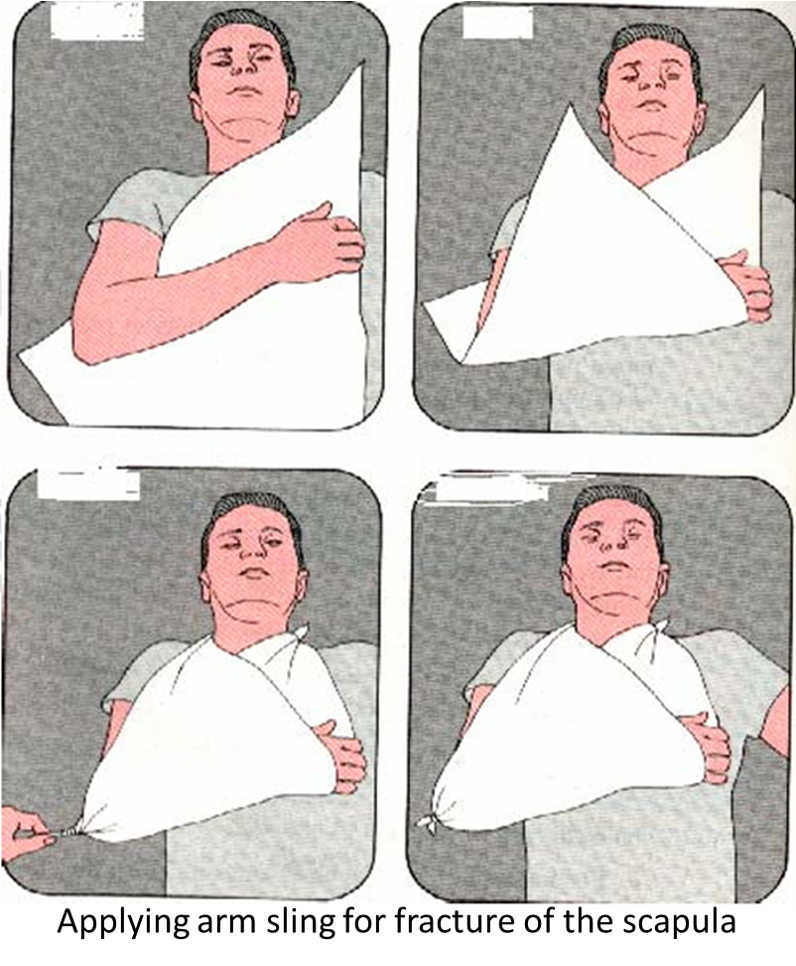
Fracture of the clavicle
Fractures of the clavicle (collar bone) usually occur in the weakest portion, which is one third of the distance from the tip of the shoulder to the sternum.
First Aid Measures
Consists of applying a sling to elevate and immobilize the arm and shoulder blade.
Fracture of the humerus (The bone of the upper arm)
First aid for a closed humerus fracture
- Place a pad in the victim’s arm pit, apply a splint or improvised splint tied in place above and below the break area (fig.31).
- Support the forearm with a sling that doesn’t produce upward pressure at the fracture site.
- Bind the victim’s upper arm to his chest wall.
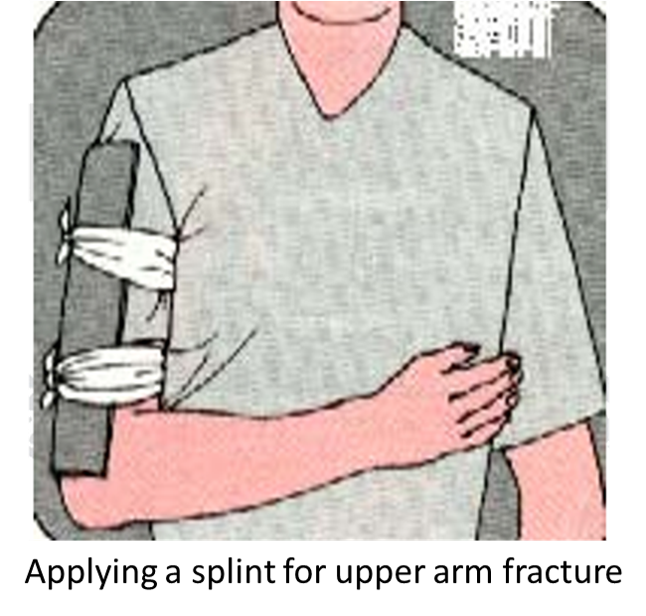
First aid measure for an open fracture
- Remove the victim’s cloth
- Control bleeding by applying direct pressure and elevating the part
- Cover the wound with a large sterile or clean dressing and apply a splint that does not press against the area of the break.
- Do not attempt to cleanse the wound and push a protruding bone back
- Arrange for transportation as soon as possible
Elbow fracture
Elbow fractures may involve the lower part of the humerus or the upper bones of the forearm.
First aid measures
- Place the victim’s forearm in a sling and bind it to his body (if the elbow can be bent).
- If the elbow cannot be bent, immobilize the fracture at the upper arm, at the elbow and at the wrist against the chest and the abdomen and at the hip.
- Lie the victim down and elevate the arm.
- If a splint is not available, wrap a pillow about the arm centering it at the elbow and tie or pin the two sides together.
Fracture of fore arm and wrist
The two bones of the fore arm (ulna and radius) may be fractured individually or together.
First aid measures
Fractures in the mid portion of the fore arm and wrist are treated in the same way as fractures of the shaft of the humerus.
- Immobilize the broken bone ends at the wrist and the elbow, by applying well –padded splints on each side.
- Bend the elbow and apply a sling with a slight elevation keeping the thumb pointing upward.
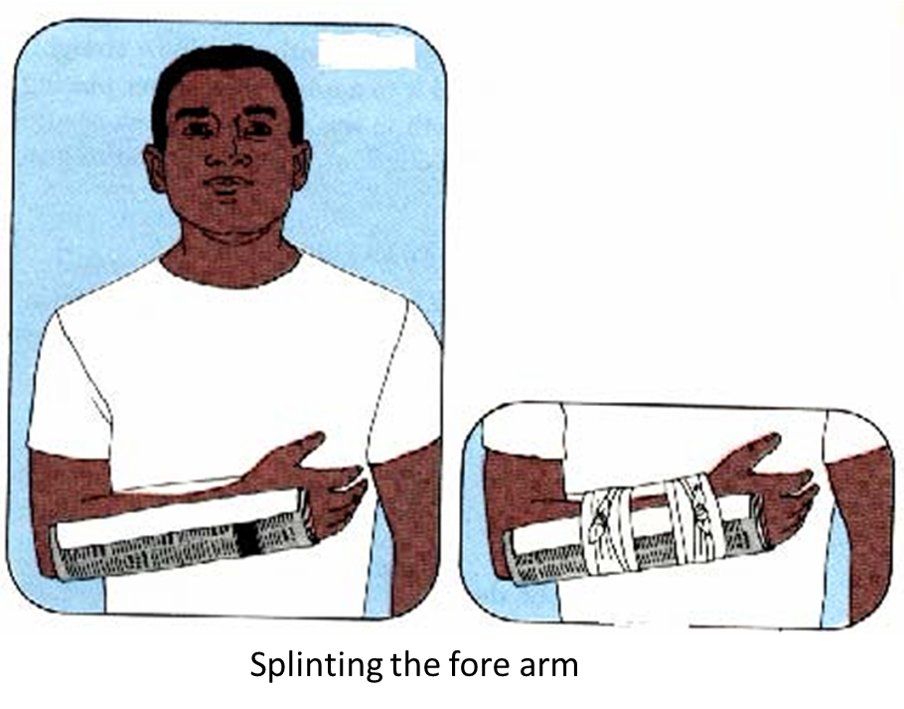
Fracture of the spine
The back bone, or spinal column is composed of 33 bones called vertebrae. It encloses the spinal cord which passes through circular
openings in the separate vertebras. Fracture of the neck or back are extremely dangerous because the slightest movement may cause further damage to the spinal cord and result in paralysis.
First aid measures for fracture of the neck (Cervical Vertebrae)
- If the victim is lying on his back, a small pad or towel may be placed in the space under his neck (do not put a pillow under his head).
- Place rolled up clothing, blankets or sand bags around to prevent movement.
- Anchor the restraining materials with bricks or stones.
- Seek medical advice and send for ambulance with trained personnel.
First aid for fracture of the back (Thoracic and lumbar vertebrae)
- Handle as gently as possible (avoid unnecessary movement).
- Send for an ambulance.
- Until help arrives leave the victim in the position in which he was found.
- Do not twist the neck or back.
- Arrange rolled up blankets or clothing on both sides of the trunk, head and neck for immobilization.
- If a person with a fracture of the back must be turned to obtain an open air way, make sure to obtain enough help so that the
entire body is turned as a unit and no part twists or turns faster than other parts. - While transferring the victim, the body should be held as a unit with the head, shoulder, trunk, the hip and the legs, each supported by one person.
Fracture of the upper leg
Fractures of the shaft of the femur usually result from falls or traffic injuries. The victim is in severe pain and shock and markedly
disabled. The foot is characteristically turned outward and the limb shortened owing to overlapping of the bone ends due to muscular spasm.
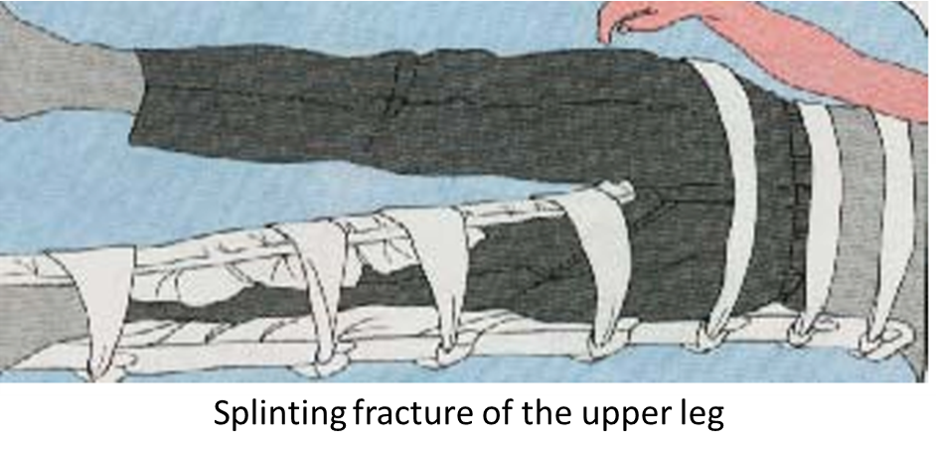
First aid measures
- If the victim is to be transported only for short distance on a stretcher, place a blanket between the legs and bind them together.
- To apply the board splint, assemble needed supplies.
- If you use improvised board splints, they should be well padded and should reach from the victim’s armpit on the outer side and groin or the inner side to below his heel.
- The bandages will be tied on the following areas: just below the arm pit, at the abdomen, at the hip, above and below the
fracture site, at the lower leg and ankle and foot with figure of eight bandage . - Don’t try to cleanse open wound (if present).
- If possible apply a traction splint for the fracture of the shaft of the femur.
Fracture of the kneecap (Patella)
The patella is in front of the knee Joint. It is fractured usually by direct injuries sustained when control of the knee is lost, with the front thigh muscles pulling violently on the kneecap.
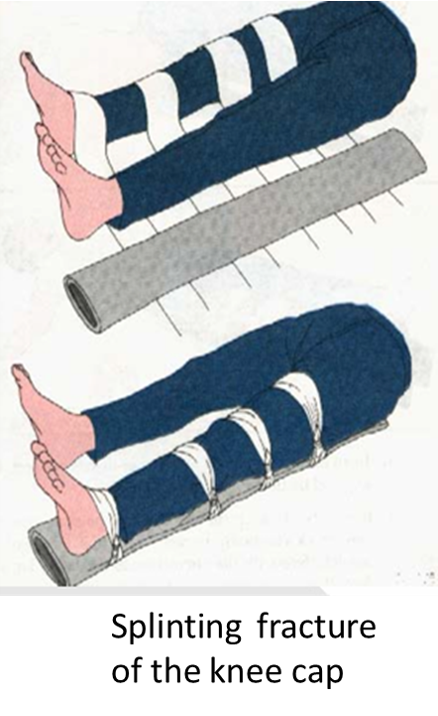
First aid measures
- Apply a pillow splint about the knee or padded splints from below the victim’s heel to his buttocks along the back of the leg, with the leg extended.
- Raise the leg slightly to prevent swelling.
- Send to hospital or a health center.
Fracture of the lower leg
The bones of the lower leg are the tibia (shinbone), which supports the weight of the body and the fibula, which forms the outside wall of the ankle and is on the outer side of the leg.
- Apply well- padded splints on both sides of the leg and foot from the top of the patient’s thigh to his foot. The splint will be
secured with a bandage at five sites as follows: at the thigh, at the knee, below and above the fracture and at the ankle and foot with a figure of eight bandage. - In an emergency, insert blankets or towels between the legs and tie them to gather.
- Remember to keep the victim’s foot pointing up ward and check for poor circulation, prevent movement of the broken bone ends, knees and ankle.
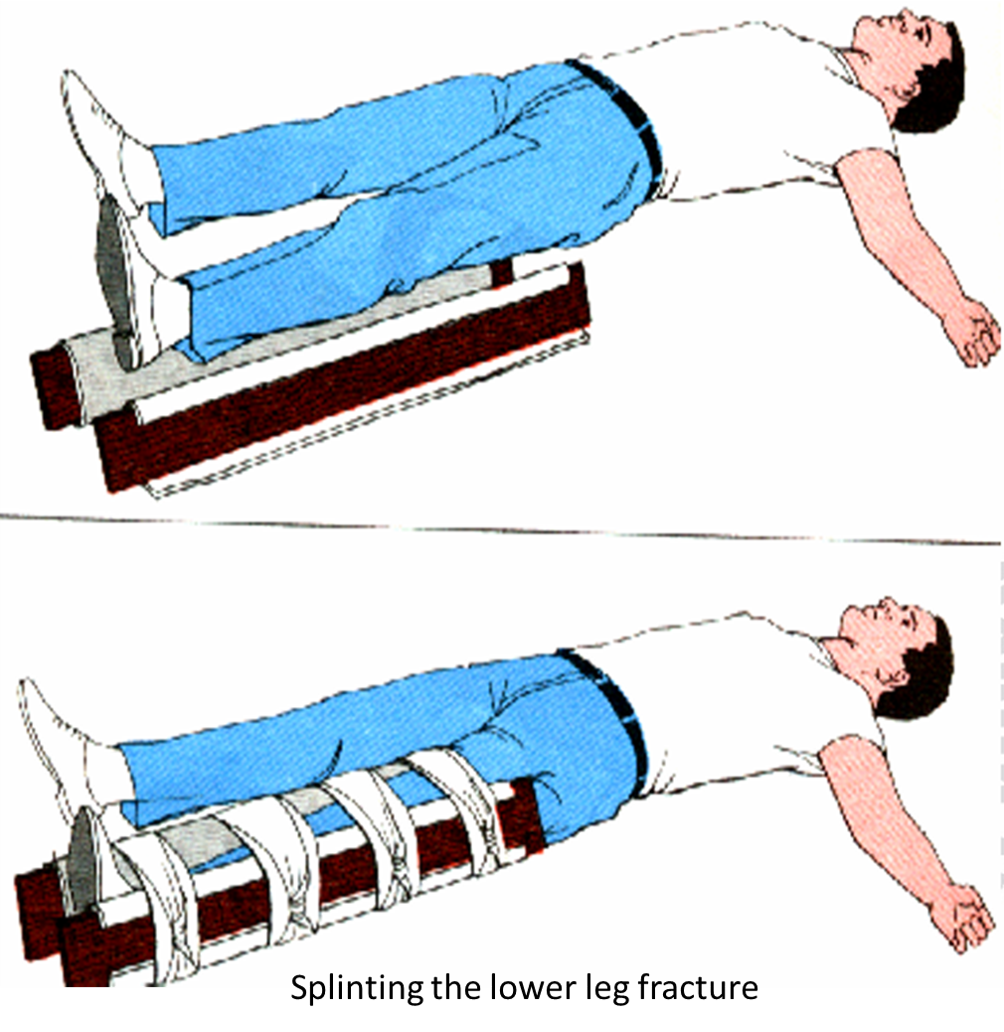
Fracture of ankle and foot
The ankle is made up of the lower ends of the tibia and fibula and the first bone of the foot (the talus). Fractures in this area occur most commonly in active sports, in falls, and in motor vehicle accident.
First aid measures
- Loosen or remove the victim’s shoes, and hose (socks) and keep him lying down with his leg elevated.
- For an open wound apply large bulky dressings.
- Splint with a pillow or blanket firmly applied with out attempting to correct the deformity
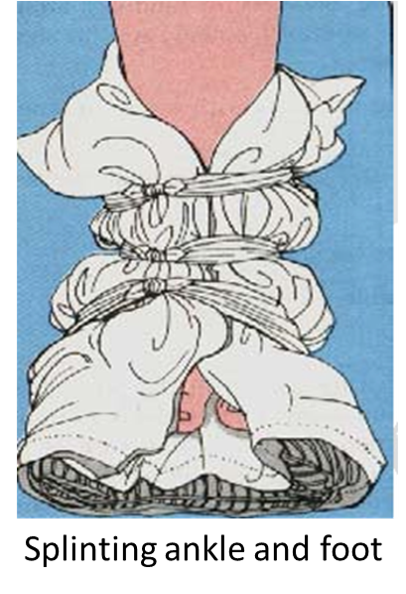
Dislocation
A dislocation is a displacement of a bone end from the joint particularly at the shoulder, elbow, fingers or thumb usually as a result of a fall or a direct blow. Unless proper care is given, arm dislocation may occur repeatedly.
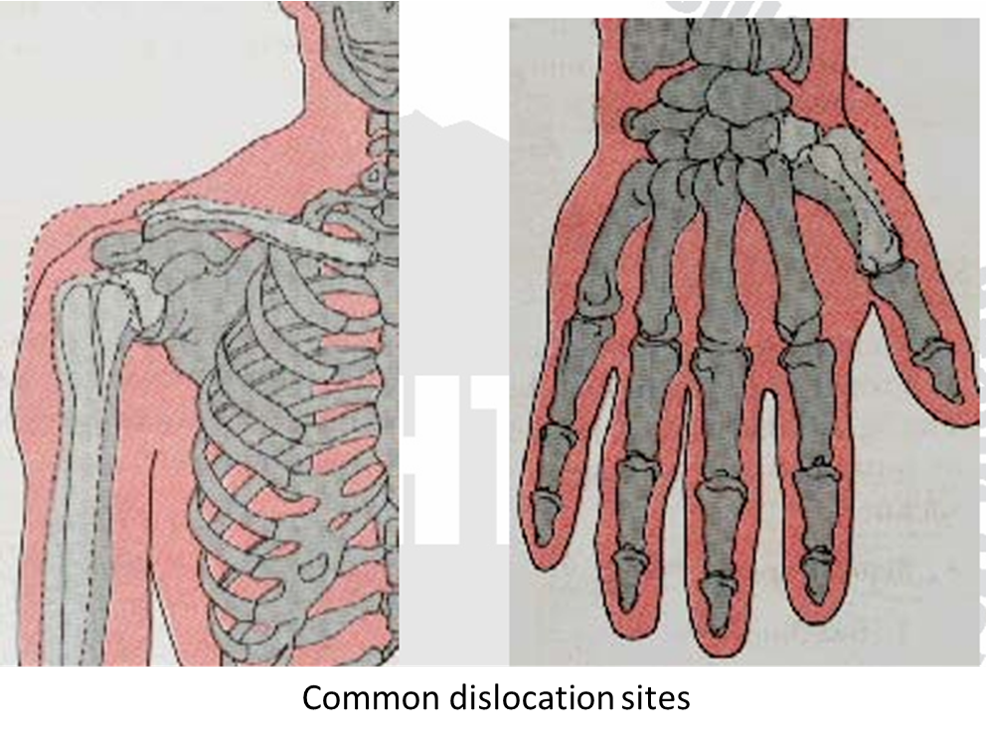
Signs and symptoms of dislocation
- Swelling.
- Obvious deformity.
- Pain upon movement.
- Tenderness to touch.
- Discoloration.
First aid measures
- Splint and immobilize the affected joint in the position in which itwas found.
- Apply a sling if appropriate.
- Elevate the affected part if a limb is involved.
- Seek medical attention promptly.
- Never attempt to reduce a dislocation.
Sprain
A sprain is an injury to a joint, ligament or muscle and tendon in the region of a joint. It occurs usually as result of forcing a limb beyond the normal range of movement. The ankles, fingers, wrists and knees are most often sprained.
Signs and symptoms of sprain
- Swelling
- Tenderness
- Pain upon motion
- Discoloration
It might be difficult to differentiate a sprain from a closed fracture with out an X-ray.
First aid measures
- If the victim’s ankle or knee is affected, do not allow him to walk.
- Loosen or remove the victim’s shoes, apply a pillow or blanket, splint and elevate the victim’s leg to prevent swelling.
- Keep the injured part raised for at least 24 hours.
- Apply cold wet pad or place a small bag of crushed ice on the affected area over a towel intermittently, to protect the victim’s skin.
- If swelling and pain persist, seek medical attention.
Strain
Strains are injuries to muscle resulting from over stretching. The fibers are stretched and sometimes partially torn. Commonly strains occur on the back muscles, due to improper lifting technique.
To avoid back strain when a heavy object must be lifted, observe the following precaution.
- Place the feet close to the object firmly and apart.
- Squat; do not lean foreword keeping the back as straight as possible and get a good grip on the object.
- Lift slowly, pushing up with the strong thigh and leg muscles are bearing the weight.
- Do not jerk the object upwards, or twist or turn your body as lifting takes place.
- To lower a heavy object reverses the above procedure.
First aid measures
- Bed rest, heat and use of a board under the mattress for firm support are recommended for person with a strained back.
- Cool the area by applying an ice pack or cold compress for the first 24 hours.
- After 24 hours, apply heat, warm, wet and rest care.
- Seek medical care; (severe back strains should be seen by a physician).
